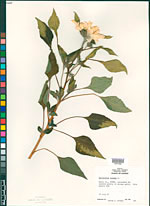These materials are an educational lesson aimed at the high school level that utilizes the Kansas State University Herbarium database to explore primary scientific data on plant specimens for counties within Kansas (adaptable to other areas). These materials were developed by KSU Division of Biology and Herbarium graduate student Susan Rolfsmeier during summer 2011, and grew in part from her experience as an NSF GK-12 fellow through the EIDRoP program. We gratefully acknowledge that grant (DGE-0841414, PI C. Ferguson), previous collaboration and discussion from USD475 teachers Becky Steiger and Drew Ising, and the KSU BiodIS project. A related lesson (“Introduction to Scientific Collections and Museum Databases”, which utilizes the BiodIS interface for collections information) is available through the BiodIS website. Please send any comments regarding these materials to .
|
Lesson Overview
In this lesson, students use online resources to learn about the flora of their home county. The students will compile data about their county flora using primary scientific data from the online Kansas State University (KSU) Herbarium database. They will learn how to access additional sources of primary data about geology, geography, etc. to enhance their study. This activity can be modified to accommodate individual or group projects. This lesson will take at least two class periods to complete and, depending on the product your students produce, time outside of class may be needed.
The first part of the lesson is designed to familiarize your students with the KSU Herbarium collections database and to introduce the concepts central to studying a county flora. The tutorial is designed to be used with a Specify software interface through the KSU Herbarium webpage. Once students have completed the tutorial and can work with the data in Excel, they are ready to move on the second part of the lesson.
In part two, the students should look at the questions they developed individually or as part of a group and write down the queries they will use. They can test their queries using the database, modify them as necessary and begin to compile the data they will use in their project.
What you and your students decide to do with your data will determine how much additional class and homework time will be needed. Suggestions are given in the instructor guide and include possibilities such as a poster, presentation, or collaborative bulletin board showcasing student findings. There are many possibilities and this part can be a way for students to be creative.
Materials and Supplies
Computers with internet access, Microsoft Excel or alternate spreadsheet software
Assessment
Completion of project (poster, presentation, flora, etc.)
Background
The aim of this lesson is to have students work with primary scientific data using a publicly available herbarium database, and to use these data to draw conclusions to their unique questions. A secondary goal of the exercise is for students to observe different aspects of place—such as aspects of geology, topography, biodiversity and land use of their county. Students may have varying levels of familiarly with their region. This exercise challenges them to look at the everyday landscape in a different way, reinforcing the fact that scientific inquiry and observation are not confined to a classroom or lab. |


